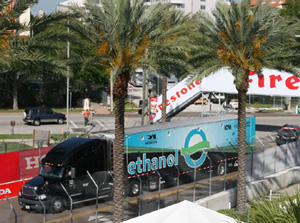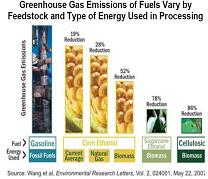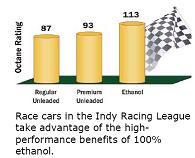Corvette Racing made motorsports history Saturday, scoring the first victory on 85 percent cellulosic ethanol racing fuel (E85R) in American Le Mans Series competition.
 Drivers Oliver Gavin and Olivier Beretta won their second consecutive class victory on the waterfront street circuit in St. Petersburg, Florida.
Drivers Oliver Gavin and Olivier Beretta won their second consecutive class victory on the waterfront street circuit in St. Petersburg, Florida.
“This was our first race running cellulosic E85 ethanol, and we had great performance and great fuel efficiency,” Gavin said. “We could have done the entire race on one pit stop. There were question marks about that from some people, but it’s been proven it’s a great fuel to run and it’s doing a bit for the green issue.”
The reigning champions won the GT1 division in the Acura Sports Car Challenge of St. Petersburg with a 4.754-second margin of victory in their No. 4 Compuware Corvette C6.R over Johnny O’Connell and Jan Magnussen in the No. 3 Compuware Corvette C6.R.
“I think we demonstrated not only to our fellow competitors but also to the world of racing that E85R is a viable and powerful fuel,” said Corvette Racing program manager Doug Fehan. “We’re very pleased with how it turned out.”
Photo Credit: Dan Boyd, American Le Mans Series



 That company is
That company is  While finding oil in the hot, dry regions of Texas might not be something new, how one company is going about it certainly is.
While finding oil in the hot, dry regions of Texas might not be something new, how one company is going about it certainly is. But instead of ponds, Valcent uses a closed, vertical system, growing the algae in long rows of moving plastic bags. The patented system is called Vertigro, a joint venture with Canadian alternative energy company Global Green Solutions. The companies have invested about $5 million in the Texas facility.
But instead of ponds, Valcent uses a closed, vertical system, growing the algae in long rows of moving plastic bags. The patented system is called Vertigro, a joint venture with Canadian alternative energy company Global Green Solutions. The companies have invested about $5 million in the Texas facility. International engineering firm Harris Group, which has a stake in the alternative energy game, has named former Imperium Renewables Vice President Mark Warner as the company’s director of the program management services.
International engineering firm Harris Group, which has a stake in the alternative energy game, has named former Imperium Renewables Vice President Mark Warner as the company’s director of the program management services. A new paper from the U.S. Department of Energy tries to put to rest some of the myths that still swirl around biofuels.
A new paper from the U.S. Department of Energy tries to put to rest some of the myths that still swirl around biofuels. MYTH: In terms of emissions, biofuels emit the same amount as gasoline or more.
MYTH: In terms of emissions, biofuels emit the same amount as gasoline or more. MYTH: Ethanol gasoline blends can lower fuel economy and may harm your engine.
MYTH: Ethanol gasoline blends can lower fuel economy and may harm your engine. A study by the Freedonia Group Inc. says that demand for biofuels throughout the world will grow by 20 percent a year to 92 million metric tons in 2011.
A study by the Freedonia Group Inc. says that demand for biofuels throughout the world will grow by 20 percent a year to 92 million metric tons in 2011. According to the
According to the  Last fall, Grassley and several other senators wrote the Environmental Protection Agency requesting testing of blends of ethanol above 10% for non-flexible fuel vehicles. Now
Last fall, Grassley and several other senators wrote the Environmental Protection Agency requesting testing of blends of ethanol above 10% for non-flexible fuel vehicles. Now